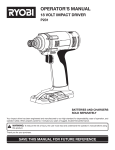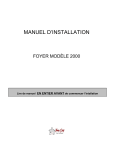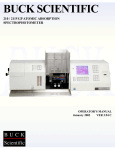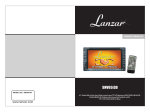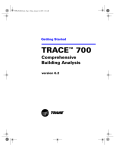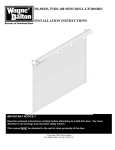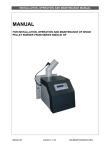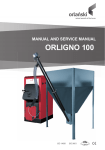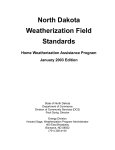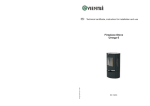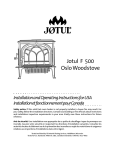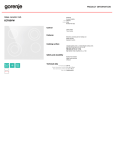Download INSTALLATION MANUAL - Foyer de masse Temp-Cast
Transcript
INSTALLATION MANUAL READ THIS ENTIRE MANUAL INCLUDING THE WARRANTY SECTION BEFORE STARTING THE INSTALLATION. Temp-Cast 2000 Installation Manual November 2000 1 TABLE OF CONTENTS SECTION 1 - INTRODUCTION General Information Site Preparation Clearances The Facade Delivery & Handling Tools Additional Materials Combustion Air Supply PAGE # 2 2 2 3 3 3 3 4 SECTION 2 - CHIMNEYS & DAMPERS General Requirements Flue Connections Masonry Chimneys Factory Built Chimneys Chimney Dampers 5 5 5 7 8 SECTION 3 - STEP-BY STEP ASSEMBLY Assembly Notes Step-by-Step Installation 9 10 SECTION 4 - DOOR FRAMES & FACADE The Door Frame Flange Installing Fire Doors Air Supply Doors Clean-out (Soot) Doors Installing "See-Through" Doors Installing Bake Oven Doors The Trim Plate Option Installing the Facade The Masonry Cap 36 37 41 41 42 43 44 45 46 SECTION 5 - AVOIDING INSTALLATION ERRORS 47 SECTION 6 – CERAMIC FIBRE CUTTING PLAN 48 SECTION 7 –WARRANTY 50 Temp-Cast 2000 Installation Manual November 2000 2 SECTION 1: INTRODUCTION GENERAL INFORMATION CLEARANCES The Temp-Cast 2000 is a modular "sitebuilt" fireplace kit. The assembled modules form the "core" of the fireplace, including internal flue passages. The Standard Fireplace package also contains a cast iron fire grate, two soot cleanout doors, refractory joint-sealing mortar, corrugated cardboard spacers, gasket material, and assorted fasteners. A minimum clearance of 4" (100mm) from the back and sides of the completed fireplace (i.e. from the masonry facing) to combustible materials is required. The clearance required from the top of the heater is 10" (250mm). READ THESE INSTRUCTIONS COMPLETELY BEFORE BEGINNING THE INSTALLATION. FAILURE TO FOLLOW THESE INSTRUCTIONS MAY CREATE A FIRE HAZARD, HAMPER THE PERFORMANCE OF THE FIREPLACE AND VOID THE PRODUCT WARRANTY. 48” (1200mm) clearance is required in front of the door & a non-combustible hearth of 16” (400mm) deep is required, extending 8” either side of the door.( approx. 38” [1m] wide). Also, a clearance of 2" (50mm) is required between the chimney and any combustible construction. (Refer to Fig 1) Fig 1 IMPORTANT: Review Section 5, "Avoiding Installation Errors" before beginning the installation! SITE PREPARATION The following instructions detail the assembly of the Temp-Cast 2000 Fireplace, on a properly prepared and supported concrete pad. Support requirements are described in the Temp-Cast Planning Guide, and related Plan Drawings. If you require assistance with the support details for the fireplace or other preparatory work, please contact your dealer or the factory. If you are unsure regarding any aspect of the installation of this product, please contact: TEMP-CAST ENVIROHEAT LTD P.O. Box 94059 Toronto, Ontario M4N 3R1 Tel: 416-322-5197 Fax: 416-486-3624 Toll-free 1-800-561-8594 Email: [email protected] Temp-Cast 2000 Installation Manual November 2000 Section 1: Introduction 3 If necessary, a metal or masonry convection shield may be placed between your fireplace facade and the combustible structure, reducing clearances by up to 67%. Contact your dealer, local building inspector or the factory for details. (In new construction, a non-combustible solid masonry wall or metal stud and "wonderboard" wall will eliminate concern with clearances.) As soon as possible after delivery, the fireplace should be unpacked and dry assembled, to become familiar with all the parts, to ensure the delivery is complete and to check for damage. ANY DAMAGED PARTS SHOULD BE REPORTED TO BOTH THE TRUCKING COMPANY AND THE FACTORY WITHIN 3 DAYS. FAILURE TO MAINTAIN THE MINIMUM CLEARANCES TO COMBUSTIBLES MAY CREATE A FIRE HAZARD. The pieces must be handled with reasonable care to avoid damage, although minor chips to corners and edges are acceptable and do not affect installation or performance. The modules should be stored indoors, in a dry area. When possible, in cold weather, the modules should be left in a heated area for a few days prior to beginning the installation. THE FACADE Once the core is assembled, it must be faced with additional suitable heat-storing masonry material, usually installed by a professional mason. (See also Section 4.) Suitable facade materials include brick, rock, fieldstone, soapstone, solid concrete block and tile or stucco, or any other solid masonry materials. (Hollow units must be filled. If using solid bricks, they should not be perfectly flat on both sides - a depression is needed to ensure that bricks do not move during thermal expansion.) THE FACADE MUST BE APPROX. 4" (100mm) OF SOLID MASONRY, STONE OR ROCK. (Substantially thinner facings may not comply with building codes, due to higher surface temperatures, requiring greater clearances to combustibles. Thicker facings will make the heater slower to respond & more difficult to regulate.) DELIVERY & HANDLING The fireplace kit weighs 2800 lbs and is delivered on a wood pallet, covered with plastic. If unloaded by forklift, it should be placed on a level and even surface, so that parts will not fall when the strapping is cut. Unpacking should be done by at least 2 persons, following the unpacking instructions. Temp-Cast 2000 Installation Manual TOOLS The following tools are required to simplify the assembly process: • • • • • • • • • • • • • 48" (1.2m) and 12” levels powered cutting tool - options include: 1. 4” grinder with diamond blade 2. circular saw with diamond blade 3. masonry “water” saw or gas concrete saw (less accurate & convenient on smaller cuts) 1/2" (12.5mm) hammer drill & masonry bits large rubber mallet 2" (50mm) margin or pointed trowel 2" packing tape (eg. “Scotch” tape) black magic marker pencil utility knife bucket, water & sponge measuring tape caulking gun 20 ft (10m) tie-down or web-clamp, for temporary support of side channels (Step 18). November 2000 Section 1: Introduction ADDITIONAL REQUIRED MATERIALS: • • • • • • all masonry facing & chimney materials Portland cement (to level the base) chimney cleanout for rear connections (see Section 4, pg 41) optional air supply door & frame (for slabon-grade installations - refer to Fig 1B) optional chimney damper (see pg. 7) 6” or 8” combustion air supply duct (e.g. galvanized duct - see next section) COMBUSTION AIR SUPPLY: The Temp-Cast heater requires an unrestricted air supply for proper combustion and maximum performance. Combustion air can be drawn from outside or inside the house and delivered by way of a 15" x 2" (380mm x 50mm) air intake formed in front of the heater during construction of the concrete floor pad. Air is then directed up behind the facing masonry, and into the hollow door frame through slots on the bottom. The air travels up inside the door frame and feeds the fire from above, creating an "air-wash" across the doors to keep the glass clean. (See Fig. 1a) Temp-Cast 2000 Installation Manual 4 If the installation is designed to use inside air from the same room as the heater, (such as in a basement installation ), then an optional "air supply door" must be purchased and installed under the loading doors. This will allow combustion air to be drawn from the room, travel up behind the facade and into the hollow door frame. (Refer to Fig. 1b). In a basement installation, outside air can still be brought into the fireplace, if ceiling height permits. In this case, a raised hearth can be constructed, and 6" (150mm) of fresh air can be fed into this structure. (A "false" chimney can be used for this fresh air supply.) The air is brought to the front of the heater into a 15" x 2" (380mm x 50mm) masonry slot or custom-fabricated "boot" and treated as a normal outside air installation. In a "See-Through" fireplace, 8” of combustion air must be supplied and divided equally to both door frames to provide an "air wash" for each door glass. (See Fig. 16, pg. 42) November 2000 5 SECTION 2: CHIMNEYS & DAMPERS GENERAL REQUIREMENTS Temp-Cast fireplaces require an approved chimney system for safe and satisfactory performance. Approved masonry and factory-built chimney systems are both acceptable. In addition to building code requirements, every chimney system should: • • • • • extend straight up from the base of the fireplace be at least 18 ft (5.5m) in height have an access at the base, with a tightfitting metal door, for chimney cleaning have a cross-sectional area of at least 50 sq. inches (320 sq cm) NOT BE CONNECTED TO ANOTHER APPLIANCE OR TO ANY AIR DUCTS FLUE CONNECTIONS The chimney connection is made at the bottom of the fireplace, in the first course. The connection can be made on either side of the fireplace or through the back wall, into the cross manifold. (Refer to Fig. # 2). The flue connection can be up to 5 ft. long, creating heated benches & allowing additional flexibility in chimney locations. For a side connection, the side channel (Part # 30 or 31) is cut to receive the connector. (see step 18.) Make this cut carefully so that a smooth transition from the fireplace to the Temp-Cast 2000 Installation Manual chimney results, free of obstructions to the flow of the escaping smoke. Use joint sealing mortar to make it completely smoke tight. The connector piece penetrates the fireplace side channel about 1" (25mm), but care must be taken to ensure that it does not protrude past the inner edge of the side channel. (See Figs. # 3 and 4.) If the connection is made at the back of the fireplace, the cross manifold (Part #3) is cut to receive the flue connector. This joint must also be smoke-tight. (See also Section 3, Step #3.) MASONRY CHIMNEYS Due to the thermal mass storage capability of masonry chimneys, we recommend them over factory built chimneys, provided they are completely inside the home. Masonry chimneys should have carefully aligned flue liners, with joints that are smoke-tight and joined with refractory mortar. The inside surface of the liner should be smooth, with all excess mortar removed. Refractory, clay and UL/ULC listed stainless steel are all acceptable liners. An access for a chimney cleanout can be cut in the first vertical flue tile. (See Fig #10, page 34) November 2000 Section 2 - Chimneys & Dampers 6 A 4” grinder with a diamond blade is ideal for cutting accurate & neat holes in the refractory concrete modules. Temp-Cast 2000 Installation Manual November 2000 Section 2 - Chimneys & Dampers FACTORY BUILT CHIMNEYS We do not recommend exterior chimneys, (see Sec. 4 of the Temp-Cast Planning Guide) but if a chimney on the outside of the house is unavoidable, then an insulated factory built (e.g. "HT" or 2100°F ) chimney is the better choice. When a factory built chimney is started at the floor level, there will not be sufficient space to access the clean-out cap under it. In order to provide a clean out access, the following method is suggested. The preferred method is to make a masonry connection to the fireplace, with 8" (200mm) round flue tile. A short section of vertical 7 masonry chimney is then constructed, with 8" round flue tile and a clean-out access built into it. (Both flue tiles should be wrapped with a corrugated or ceramic wool spacer and cemented in position.) An approved anchor plate for the factory-built chimney is installed on top of the masonry section and the factory built chimney continues from this point, as in Fig. 5. (Confirm this connection method with your local building official.) If desired, a sliding chimney damper can be built into the masonry chimney section. Other methods of connecting factory-built chimneys may be acceptable. Consult the chimney manufacturer, a certified installer or your local building official. We recommend that the “anchor plate” be located hidden from view between the 1st & 2nd floor joists – only the masonry section is visible on the first floor & the pre-fabricated chimney starts at the 2nd floor. Temp-Cast 2000 Installation Manual November 2000 Section 2 - Chimneys & Dampers INSTALLING THE ROOF-TOP CHIMNEY DAMPER An optional “roof-top” chimney damper can be installed to allow the chimney to be closed off when the fire is out. This will let the chimney mass hold additional heat and greatly improve the overall heating efficiency of the system. (Refer to the Temp-Cast Owner's Manual for proper use of the chimney damper.) 8 Carbon monoxide has the potential to be fatal. We therefore strongly recommend installation of a carbon monoxide alarm, available where smoke alarms are purchased, to guard against this possibility. The damper is cemented to the top of the uppermost flue tile of the chimney, and is controlled by a cable through the centre of the chimney. (See Fig. 7) The cable is routed through the side of the flue tile during construction of the chimney and masonry facing. (Note: Installation of the damper cable is greatly simplified if the protective sleeve and steel cable are installed in the desired area when the chimney is being built. If this has not been done, then a string will have to be fished through the sleeve & secured to the steel cable.) The cable bracket should be attached to the outside of the chimney in a convenient and unobtrusive location but out of the reach of small children. (Refer to Detail 7a) For 8” round chimneys, including factorybuilt models, a Round-to-Square adapter and a 13” x 13” damper will be required. NOTE: When a stainless steel chimney is used, penetrating the steel chimney is not permitted. We recommend first building a masonry section & routing the cable through this. Install an approved masonry adapter & start the factory chimney at this point. (See Fig 5.) CAUTION: Whenever a full-closure damper is used, care should be taken to ensure that the fire is completely out before the damper is shut. Closing the damper prematurely could cause combustion gases, especially carbon monoxide, to be spilled into the home. Temp-Cast 2000 Installation Manual NOTE: the chimney damper bracket should be placed out-of-view whenever possible, provided it can still be accessed easily. November 2000 Section 3 - Step-By-Step Assembly 9 SECTION 3: STEP-BY-STEP ASSEMBLY ASSEMBLY NOTES 1. Dry assemble the heater upon delivery, to check the condition of all parts and to familiarize yourself with the modules. (If all of the parts are not numbered, you may find it helpful to do so, using this manual, before taking the unit apart again.) 2. Cutting of flue tiles and fireplace modules should be done outdoors due to the excessive dust created. WEAR SUITABLE EAR, EYE AND LUNG PROTECTION. 3. A 4” grinder with a diamond blade is best for cutting holes in flue tiles and fireplace modules. Or round holes can be cut as six or eight-sided shapes with a gas, water or circular saw or drilled every inch (25mm) and then cut with a reciprocating saw fitted with a masonry blade. Rounding or beveling the inside edges of the hole in the module creates the least resistance to the flow of smoke and gases, maximizing draft and performance. (See Fig. 8) 4. When using the ceramic fibre gasket material, it should only be slightly compressed. Compressing it too much will defeat its purpose as an expansion gasket. (A small amount of refractory mortar can be used to cement the gasket in position.) 5. Refractory casting occasionally leaves behind rough spots or small bumps on the modules. If these rough spots should occur in a joint between 2 modules, they may prevent a tight joint and make installation of subsequent parts more difficult. Remove any such bumps with a rasp or scraping tool before assembling. 6. Refractory mortar should be used sparingly, applying a small (1/4” to Temp-Cast 2000 Installation Manual 3/8”) bead between modules. The finished joint should have a very thin skin of refractory mortar, which is the strongest. (In addition, the parts will only fit properly if the thinnest possible joint is created.) Apply a small amount on the outside edges of the part, where indicated by the shaded areas. Do not use a full bed of mortar. Seat the parts completely, using a rubber mallet, so that a little mortar squeezes out. After each course, scrape off and save excess mortar for possible later use. Periodically wipe the modules inside and out with a damp sponge to ensure that excess mortar has not been left behind. Fig. 8 November 2000 Section 3 - Step-By-Step Assembly 10 STEP 1: "THERMOTECT" INSULATING BOARD If an optional insulating board is to be installed, it is installed before starting the Leveling Pad. Cut the board to size as indicated and place it in position. Check that it is square to the concrete floor pad. Ensure that the air intake hole is located immediately in front of the board and centered. (It is also advisable at this point to double check that there will be sufficient clearances to combustible construction around the fireplace.) If you have followed the Temp-Cast Planning Guide, the area around the 6" diameter Ash Drop hole in the concrete pad will be sloped towards the hole for a few inches all around. Cut an appropriately sized hole in the insulating board so that the sloped area around the hole is not obstructed. Lay the board in position as illustrated. Temp-Cast 2000 Installation Manual November 2000 Section 3 - Step-By-Step Assembly 11 STEP 2: "Dry" assemble (i.e. without mortar) the two halves of the Leveling Pad (Part #1 & #2) on the "Thermotect" board, or on the concrete floor pad, so that the air intake slot is not obstructed and is centered in front of the Leveling Pad. Ensure that the 6" (150mm) diameter ash drop is located within the cut-out section of the base. CHECK THAT THE FLOOR IS REASONABLY LEVEL BEFORE STARTING TO INSTALL THE LEVELLING PAD - ADDITIONAL MORTAR MAY BE NEEDED TO LEVEL IT AS REQUIRED. Lay the two halves of the Leveling Pad in a 1/2" (12mm) bed of common mortar, using refractory mortar between them. Using the 48" level, tap the base into the mortar, ensuring that it is level. Before the mortar has set, tap down along the centre-line of the leveling pad, so that the centre of the pad is about 3/16” lower than the sides. (See illustration below.) This centre-line gap will ensure that parts in the upper courses lean in slightly, simplifying installation. Weights #1 & 2 - 49 lbs #1C & 2C - 59 lbs Temp-Cast 2000 Installation Manual November 2000 Section 3 - Step-By-Step Assembly 12 STEP 3: When the Leveling Pad can support weight, dry assemble the first course of modules, including the grate, as in the accompanying drawings, to check for proper fit. This course is to be centered on the Leveling Pad, so that equal space is left on both sides for the heat exchange channels - mark the correct placement with a pencil. If the chimney is to be connected at the rear of the fireplace, mark the cross manifold (#3) to be cut for the flue connection. Take this part outdoors and cut a hole for the flue connector being used. For flue tile or HT chimney, cut the hole the same size as the inside dimensions of the flue connector. The flue connector or HT adapter will then be mortared or attached to the outside of the cross manifold - Part #3. (Holes for a side connection are discussed at Step 18.) Once the layout of fireplace and chimney connection, all dimensions and locations of cleanout doors have been confirmed, draw a line on the Leveling Pad to mark the outside edges of the base course. Now remove the modules, (cut the flue hole in #3 if required) and re-assemble, using a small amount of the refractory mortar provided on the bottom edges and between modules. Seat the parts with the rubber mallet, then reach inside the cross manifold and wipe off all excess mortar. NOTE: once final assembly has been started, the entire core should be assembled in a continuous operation, so that minor adjustments to previous courses can be made before the refractory mortar has set. Place the firegrate in position, which should fit loosely to allow for expansion. Cover it to keep clean. Weights #3 - 61 lbs #4& #5 - 82 lbs #6 - 22 lbs Temp-Cast 2000 Installation Manual November 2000 Section 3 - Step-By-Step Assembly 13 STEP 4: Assemble the second course, parts #7, #8 & #9. A small bead (½”) of refractory mortar is laid on the outside edges where the two parts meet. (The bead can be laid either on the part being laid on or the previous part - whichever is easier.) Note that the parts are numbered in the order that they should be placed. (For a Temp-Cast "See-Through" fireplace, these 3 parts are slightly different, as in the accompanying illustration.) Use the rubber mallet to seat the modules. Remove excess mortar and wipe inside and out with a damp sponge as work progresses. NOTE: When installing the modules on this course and subsequent courses around the firebox opening, take care that the parts are flush at the front of the fireplace. This will produce the most level surface on which to install the door frame later. Weights #7 - 52 lbs #8, #8ST, #9, #9ST - 68 lbs Temp-Cast 2000 Installation Manual November 2000 Section 3 - Step-By-Step Assembly 14 STEP 5: Install Part# 10 as shown and then assemble modules 11, 12 &13, using refractory mortar. Center Part#10 in the space and then fill in on each side with some ceramic wool. (Note that parts 11 thru 13 are identical to the previous course.) (In the "See-Through" fireplace, there is no part #11.) Seat with the rubber mallet and ensure that joints are tight. Remember to keep the front edges of the modules aligned and use a 48” level to ensure that the four sides are plumb. Leveling the courses is not critical – it is sufficient if the courses are approximately level. Weights #10 - 12 lbs #11 - 52 lbs #12 & #13 - 68 lbs #12ST & #13ST - 68 lbs Temp-Cast 2000 Installation Manual November 2000 Section 3 - Step-By-Step Assembly 15 STEP 6: Install the lintel course, parts 14, 15 & 16, in order, using a small (3/8”) bead of refractory mortar on the outside edges of the adjoining parts. Weights #14 & #14 ST- 86 lbs #15 & #16 - 64 lbs Temp-Cast 2000 Installation Manual November 2000 Section 3 - Step-By-Step Assembly 16 STEP 7: Complete the lintel course with part # 17. Ensure that it aligns with the front edges of the previous course. Seat firmly with the rubber mallet to ensure thin, strong joints and stable support for the next course. (If necessary, this course can be clamped with a tie-down until the refractory mortar sets.) Weights #17 - 84 lbs Temp-Cast 2000 Installation Manual November 2000 Section 3 - Step-By-Step Assembly 17 STEP 8: The smoke throat course is started by installing module #18. This part is heavy and awkwardly shaped and may require a helper. Weights #18 - 93 lbs Temp-Cast 2000 Installation Manual November 2000 Section 3 - Step-By-Step Assembly 18 STEP 9: Continue the smoke throat course with parts 19 & 20. (Note that the slightly beveled surfaces of these modules face in towards the firebox.) Weights #19 & 20 - 35 lbs Temp-Cast 2000 Installation Manual November 2000 Section 3 - Step-By-Step Assembly 19 STEP 10: Complete this course by installing #21. Remove all excess mortar and wipe the modules inside and out. Weights #21 - 93 lbs Temp-Cast 2000 Installation Manual November 2000 Section 3 - Step-By-Step Assembly 20 STEP 11: These 2 parts, #22 & 23, form the floor of the secondary combustion chamber. They are not keyed and are simply mortared in position with a thin bead of refractory mortar. (If this installation includes a Bake Oven, these parts and subsequent courses are detailed on page 26.) Tap firmly into place with the rubber mallet, to create as thin a joint as possible. Weights #22 & 23 - 40 lbs Temp-Cast 2000 Installation Manual November 2000 Section 3 - Step-By-Step Assembly 21 STEP 12: Mortar and place the lower rear wall of the secondary combustion chamber, part #24. (Note that the bottom edges of the parts on this course are not keyed.) Weights #24 - 66 lbs Temp-Cast 2000 Installation Manual November 2000 Section 3 - Step-By-Step Assembly 22 STEP 13: Install the 2 short side walls of the secondary combustion chamber, parts 25 & 26. These parts are not keyed and may have to be checked periodically to ensure they don't get out of position while the refractory is drying. Weights #25 & 26 - 36 lbs Temp-Cast 2000 Installation Manual November 2000 Section 3 - Step-By-Step Assembly 23 STEP 14: Install the lower front wall of the secondary combustion chamber, part # 27. Seat this part with the mallet & double-check the position of the side walls - adjust with the rubber mallet as required. Weights #27 - 66 lbs Temp-Cast 2000 Installation Manual November 2000 Section 3 - Step-By-Step Assembly 24 STEP 15: Install part #28, the upper rear secondary combustion wall. This is also a heavy part and may require 2 people, so that the previous course does get disturbed. Installation is easiest if the bottom of the module is placed first into position and then raised upright. So this part does not tilt inwards, a little extra refractory mortar can be used on the inside edge of the part. Weights #28 - 126 lbs Temp-Cast 2000 Installation Manual November 2000 Section 3 - Step-By-Step Assembly 25 STEP 16: Part #29 is installed to complete the secondary combustion chamber, forming the front wall. These 2 upper walls may have a tendency to lean inward while the mortar is setting. Adding a little extra mortar to the inside edges of this part will help to keep it from leaning in. Leaning can also be prevented by making a simple wood jig. Cut a length of 2x4, 11-7/8” long. This piece will be the "spacer". Nail this piece to a longer piece of wood. Place the jig on top of the walls, so that the spacer hangs down and prevents the two walls from leaning inward. (This jig can be left in place until Step 22.) Weights #29 - 126 lbs Temp-Cast 2000 Installation Manual November 2000 Section 3 - Step-By-Step Assembly 26 STEPS 11 THRU 16: (Bake Oven Installation) Assemble the Bake Oven parts, in numerical order, as illustrated below. Parts 22B and 23B are laid with a bead of refractory mortar around the outside edges of the parts and seated with the rubber mallet. Use refractory mortar wherever one part joins another, as indicated by shaded areas. Weights #22B, #23B & #24B - 48 lbs #25B &26B - 51 lbs #27B - 126 lbs #28B -100 lbs #29B - 114 lbs Temp-Cast 2000 Installation Manual November 2000 Section 3 - Step-By-Step Assembly 27 STEP 17: Find the ceramic fibre "Cutting Plan" in Section 6 for the model you are installing. With a tape measure, magic marker & straight-edge, transfer the "Cutting Plan" dimensions & piece numbers to the ceramic fibre. Cut out the four (4) strips marked "3"x72" (Side Channels)" K1 thru K4, and glue them to the exterior of the core as shown below, using five or six evenly spaced small dabs of refractory mortar. Temp-Cast 2000 Installation Manual November 2000 Section 3 - Step-By-Step Assembly 28 STEP 18: If the flue connection is on the side of the fireplace, the hole for the flue connector is cut at this point, as shown. (See below for important suggested cutting technique.) (Refer also to Fig. #3 & #4 on Page 5.) (For a Corner Fireplace, see page 31, for Steps 18 to 20.) Dry assemble the lower heat exchange channels, #30 & 31, and mark the location of the flue hole. The hole in the heat exchange channel should be cut as tightly as possible, up to about 1/4" larger all around than the flue tile. In addition, cut a 6" x 6" hole in the opposite heat exchange channel, on the non-chimney side, for a soot cleanout door. Align this hole with the centre of the cross manifold, part # 3. (If a rear chimney connection has been made, the second soot door may be installed on the opposite side channel, to simplify inspection and cleaning from both sides. Both soot doors should align with the centre of the cross manifold. A third cleanout door will be needed for the base of the chimney.) The transition from fireplace to flue connector should be as smooth and rounded as possible, so that the smoke does not encounter any corners or ledges as it enters the flue connector. (Refer to Fig. 8, page 9.) Ensure that the ceramic fibre strips have been applied to the core walls. Now position the first 2 heat exchange channels, using refractory mortar on their bottom edges only. Use a “tie-down” or web clamp around the 2 channels to slightly compress the ceramic fibre. Secure the channels with 2 bands of packing tape, then remove the tie-down. Temp-Cast 2000 Installation Manual Weights #30 & 31 - 95 lbs November 2000 Section 3 - Step-By-Step Assembly 29 STEP 19: Set the middle heat exchange channels (#s 32 & 33) in place, using a thin joint of refractory mortar between channels. (If mortar squeezes out on the inside surface of the heat exchange channels, wipe if off. Keeping the mortar back from the inside edges will prevent having to reach in to wipe off excess mortar from this area.) Slightly compress the ceramic fibre using the tie-down and secure these two channels with 2 bands of packing tape, as illustrated. (The packing tape can be left in position when the facing is being applied and then any visible tape can be cut out.) Weights #32 & 33 - 95 lbs Temp-Cast 2000 Installation Manual November 2000 Section 3 - Step-By-Step Assembly 30 STEP 20: Install the upper heat exchange channels, #34 & 35. Note that these are slightly different than the other 4, with a transition formed on the inside upper surfaces, and an enclosed top. Use a thin refractory mortar joint between these and the previous channels and secure these parts with the tie down and packing tape. Weights #34 & 35 - 95 lbs Temp-Cast 2000 Installation Manual November 2000 Section 3 - Step-By-Step Assembly 31 STEPS 18 THU 20: (Corner Fireplace) If the chimney connection is to be made in the side of the fireplace, dry assemble the first corner channel and mark the location of the flue hole on the designated surface. Mark a location for a clean-out (soot) door on the opposite channel. Cut these holes outside. Re-assemble the first two corner channels, using a little refractory on their bottom edges. Use a tie down and 2 bands of packing tape or fiberglass-reinforced tape around each pair of channels - so they do not fall during the next few steps. Continue with the other four corner channels, using refractory mortar between them. Secure each pair of channels with 2 bands of packing tape or fiberglass re-inforced tape as they are installed. Weights #30C to 35C 130 lbs Temp-Cast 2000 Installation Manual November 2000 Section 3 - Step-By-Step Assembly 32 STEP 21: Install a gasket of strips of ceramic wool to the top of the fireplace, as illustrated below and described as follows. (A little refractory mortar can be used to keep gaskets in place.) Glue down the 2 strips marked 'K5 & K6 3"x36"(Top Front and Top Rear)' to the top of the heater, across the width, at the front and rear, as illustrated. (Note: the fibre should be roughly flush with the outside edges of the heater.) Now fill in the remaining spaces with strips marked 'K7 & K8, 3"x16" (Top Side)' The next layer of gasket is staggered, overlapping the joints of the first layer, starting with the 2 strips marked 'K9 & K10, 3" x22" (Top Side)' placed at either side of the fireplace and running the full depth. Then the front and rear pieces are filled in with strips marked 'K11 & K12, 3"x30" (Top Front) or (Top Rear)'. Trim the strips as required for a snug fit. (Corner fireplace gaskets are placed with the same principle in mind.) Note: if the tops of the side channels & the heater do not end up even, use extra ceramic wool to make the top edges even to within approximately ¼" all around. Temp-Cast 2000 Installation Manual November 2000 Section 3 - Step-By-Step Assembly 33 STEP 22: Place the two halves of the fireplace lid on top, using a refractory mortar between them. (The smoothest side should be placed down - the parts are interchangeable left to right.) Note that no mortar is used between the lid and the ceramic gasket. Since the lid is slightly smaller than the top of the fireplace, an equal amount of space should be left all around. Weights #36 & 37 - 80 lbs #36C & 37C -95 lbs Temp-Cast 2000 Installation Manual November 2000 Section 3 - Step-By-Step Assembly 34 STEP 23: Cut the flue connector to the correct length and with the correct angle, so that it rises up 1"/ft (25mm/300mm) towards the chimney. Install the flue connector with refractory mortar to the heat exchange channel and support it in the correct position. NOTE: extra care must be taken to be certain that the flue connector does not go beyond the inner surface of the heat exchange channel. Ideally, the connector should penetrate the heat exchange channel no more than one inch (25mm). (Refer also to Fig.3, page 6.) Reach inside the flue connector to smooth and round the corners of the connection. Remove excess refractory mortar from the inside edges of the flue connector. Cut the first vertical flue tile, as shown in Figure # 10. Note that the chimney cleanout is shown in the preferred position - in-line with the flue connector. If this alignment is not possible, the cleanout can be on either of the other 2 available sides. (If a chimney clean-out is planned for a lower level, a soot door should still be installed at the flue connection level, for inspection and removal of fly ash which will accumulate at the bottom of the heat exchange channels.) Wrap the flue connector and the first vertical flue tile with extra ceramic wool, "coreflex" or cardboard spacer and mortar them solidly in position with common mortar. ALL JOINTS MUST BE SEALED WITH REFRACTORY MORTAR TO BE SMOKE TIGHT. Temp-Cast 2000 Installation Manual November 2000 Section 3 - Step-By-Step Assembly 35 STEP 24: Remove the “tie down”, but leave the tape in place. The heater now needs to be completely wrapped with the corrugated spacer supplied, but openings for fire-doors, bake-ovens, air doors and cleanouts may have to be pre-cut, so that the packing tape is not inadvertently cut. To pre-cut the opening for the firebox, lay 2 pieces of corrugated spacer on the floor, with their longest sides butting. Measure up from the bottom of the spacer 13½" and draw a horizontal line across the spacer. Measure over 6" from either side edge and draw a vertical line at this point. Remove the door from the frame and place the frame on the spacer, using the two lines drawn to position the bottom and left edges of the frame. Trace around the entire frame and then remove the frame. Cut the approximately ½" larger than the traced line on all sides & remove the piece. Place these 2 cut pieces on the front of the heater, starting at the bottom. Continue with other pieces of corrugated spacer around the heater, but pre-cut any holes for cleanouts, air doors, bake-ovens etc using the same technique as the firebox doors, to prevent cutting the packing tape. Tape the spacer in place. (For corner units, a flexible “coreflex” spacer is supplied. Wrap this around the heater twice to get the correct thickness.) Also cut out a section of spacer in the area of the air intake slot, directly under the firebox, as illustrated. The core of the Temp-Cast 2000 is now complete. The next section details installing the facade and the doors. Temp-Cast 2000 Installation Manual November 2000 Section 4 - Installation of Door Frames & Facade 36 SECTION 4: DOOR FRAMES & FACADE THE DOOR FRAME FLANGE: Fig. 11 The Temp-Cast door system was designed so that a standard brick, with a nominal thickness of 3.75”, could be easily installed behind the door flange. However, since brick sizes vary greatly across North America, masons often cannot find a suitable brick in these dimensions. In addition, natural stone and rock often cannot be found in these dimensions. FACADE/ FLANGE OPTIONS: The following techniques will allow thicker facades to be concealed behind the door flange. FOR FACADES UP TO 4.25” THICK: Glue an extra layer of 1/2” ceramic fibre between the door frame and the heater core, on top of the standard 1/2” layer. When slightly compressed, this extra layer will provide up to 3/8” additional space behind the door flange. (Refer to Fig. 11) Fig 11a FOR FACADES OVER 4.25” THICK: For facades more than 4.25” thick, a “row-lock” bond can be employed, in which half-bricks are cut to approx. 3” and laid around the door frame, fitted behind the flange. Thicker facade materials can then be laid up next to these row-lock bricks. (See Fig. 11a) Alternatively, attach fire-brick “splits” around the door frame opening with refractory mortar, before the ceramic wool is applied. These splits, up to 1.5” thick, increase the space between the core and the flange, allowing for a thicker facade material to fit behind it. (In all cases, increase the combustion air space under the door by the thickness of the added splits - e.g. cut an extra 1.5” from the facing under the door if 1.5” splits are added.) Temp-Cast 2000 Installation Manual November 2000 Section 4 - Installation of Door Frames & Facade 37 INSTALLING FIRE DOORS Although experienced masons may use a different technique to attach the door frame, the following method ensures two critical points: • • The finished door frame will not be permanently attached directly to the core and will therefore not be affected by thermal expansion of the refractory. (See Fig. 11b) Air slots in the bottom of the frame and in the concrete floor pad are properly aligned, as in Fig. 12. the slope of the bottom inside edge of the frame (i.e. the "sill" of the door frame) and the slope of module # 10 form a nearly continuous angle, as in Fig. 12. Level the frame and make a pencil mark on the cardboard spacer along its bottom edge. (Note: rear doors on a See-Through Fireplace are positioned slightly higher than the front doors about 1.5". Refer to Page 42, Fig. 16) The door frame position can be adjusted up or down slightly to accommodate the facade, so that the frame will sit on top of a masonry or stone course. However, ensure that the door frame still covers the firebox opening, particularly on the top, in the case of an arched frame. (See Fig. 13) FIRE DOORS - Step One Remove the doors from the frame and set them aside. Position the door frame on the core so that Note: Use an angle iron to support the masonry when a rectangular door frame is installed. Fig. 11b Temp-Cast 2000 Installation Manual November 2000 Section 4 - Installation of Door Frames & Facade 38 To keep the door clean, it can be removed from the frame and installed when the facing is completed. Temp-Cast 2000 Installation Manual November 2000 Section 4 - Installation of Door Frames & Facade FIRE DOORS - Step Two Build up the masonry facade to the bottom of the firebox door. Adjust the height of the door frame as needed to suit the masonry courses, ensuring the frame still covers the firebox opening. Trace the frame on the cardboard spacer. Using a small amount of refractory mortar, glue a 3" wide strip of ceramic wool to the face of the core where the cardboard was removed. (Pieces K13 thru K15 on the ceramic wool cutting plan) Place the door frame in position & brace it firmly with a length of 2x4 wedged under the one of the hinges & nailed to the floor. A second 2x4 can be braced under the upper door opening. (Alternately, the frame is fitted with 2 small brackets, which can be used to temporarily secure the frame to the core with the “tap-con” screws supplied.) NOTE: ensure that the ceramic gasket is slightly compressed, but not crushed. WARNING! It is important that the ceramic fibre be slightly compressed and glued in place, so that it cannot fall out. This will ensure that live embers cannot fall into the space between the door and the heater core, or into the air intake and create a potential fire hazard. 39 Cover the door frame to keep it clean for the rest of the installation. Continue to Step 3. IF THE FLANGE WILL NOT COVER THE FACADE: If the masonry facade will not be hidden behind the door flange, care must be taken to ensure that an expansion gap is created between facade and door frame. Glue a 3" strip of ceramic wool (pcs K13 thru K15) onto the core where the cardboard was just removed. Place the door frame in position & bolt it or brace it with 2x4s. The bottom flange of the door frame rests on the masonry. Place 4" (100mm) wide strips of corrugated spacer (or "coreflex") on the top and sides of the frame. Continue with Step 3. However, ensure that an expansion gap of about 1/8" (3mm) is left between the masonry and the side and top flanges of the door frame. (See Fig. 14) No combustible materials should be installed in the foundation or under the foundation, due to the potential fire risk!! WRAP BOTH SIDES & TOP OF THE DOOR FRAME WITH “COREFLEX” (FLEXIBLE CARDBOARD), OR CORRUGATED SPACER.. (If a spacer is not used between the frame & the masonry facing, thermal expansion of the frame could crack the facing and/or the mortar joints.) Temp-Cast 2000 Installation Manual November 2000 Section 4 - Installation of Door Frames & Facade FIRE DOORS - Step Three Continue with the masonry facade, up to the level of the first permanent bolt attachment. Insert the four permanent bolts into the frame. 40 cavity is created around the area of the bolt. (Refer to Fig. 15) Continue raising the facade, filling the space around the bolt with mortar, tight to the "coreflex" spacer. Chip or cut the brick or other masonry, so that a Temp-Cast 2000 Installation Manual November 2000 Section 4 - Installation of Door Frames & Facade FIRE DOORS - Step Four When the facade is complete and the masonry has fully set, remove the 2 temporary bolts from the frame. (If the 2 small brackets were used, this will detach the frame from them.) The door frame is now independent of the fireplace core and will not be affected by the thermal expansion of the core. Replace the doors on the frame and check for proper fit and operation. ALTERNATE ATTACHMENT METHOD: If cutting or chipping masonry around the bolts is not advisable, an alternate (but more difficult) attachment method can be used. (See Fig. 15.) Remove the 4 permanent bolts from the door frame. Build the facade around the door frame (or around the flange, as the case may be) and complete the masonry work. When the masonry work is fully set, (i.e. after 1 or 2 days) make a mark on the masonry where the 4 bolts will go, using the bolt holes as a guide. Care must be taken at this point so that the threaded holes on the outside of the frame are not damaged. Now unbolt the frame from the 2 temporary brackets and take the door frame out. (If the "coreflex" spacer comes out with the frame, replace it before the frame is re-installed.) Using a masonry drill of the same thickness as the permanent bolts, drill holes into the masonry at the marks made earlier. These holes should be at least 1" (25mm) deep and on a slight angle (about 5 degrees) towards the firebox. (Fig. 15) Re-install the door frame and attach with the four permanent bolts - the slightly angled holes will draw the frame tight to the ceramic wool gasket. (Do not re-bolt the frame to the temporary brackets.) AIR SUPPLY DOORS If an air supply door is to be installed, its frame is installed in the facade when it reaches the desired height. (See Fig. 1b, pg. 4). The Temp-Cast 2000 Installation Manual 41 installer can use mortar, lead anchors or "tapcon" screws to secure the door frame. CLEAN-OUT DOORS Similarly, clean-out (soot) door frames are installed when the facade reaches the height of the clean-out holes in the heat exchange channels. The soot doors should be located on both sides of the heater, at the bottom of both heat exchange channels, in line with the crossmanifold, Part # 3. When a side chimney connection is made, one of the two clean-out doors should be placed at the bottom of the chimney, so that the bottom of the heat exchange channel on that side can also be accessed from the same door. In the case of a rear chimney connection, a third clean-out door will be required for the chimney itself. (Standard chimney clean-outs are available at brick supply yards or a third Temp-Cast cleanout can be ordered.) Cover all door frames immediately after installation to keep them clean. INSTALLING "See-Through" DOORS The installation of a second set of fire doors for a “See-Through” Fireplace will follow the same steps as previously detailed. However, the finished height of the rear doors will be about 1.5" (380mm) higher than the front doors. (Refer to Fig. 16). This dimension can be adjusted down a little, but care must be taken so that the door frame is sealed against the ceramic gasket on all four sides of the firebox opening and a reasonably smooth transition from the door sill to Part #7ST results. (It is important that air enters the firebox only from the slots in the top of the door frame.) In addition, the installer must ensure that half of the 8” dia. combustion air supply is fed to the second door, and that an identical air slot is created behind the facade, under the door frame, on the rear side of the fireplace. (Without this provision, the rear doors will not have an air wash and will become dirty.) November 2000 Section 4 - Installation of Door Frames & Facade 42 Fig. 16 Temp-Cast 2000 Installation Manual November 2000 Section 4 - Installation of Door Frames & Facade 43 wool around the opening, so that a gasket is formed between the door frame and the core. (Use ceramic wool pcs K17 & K18) (See Fig. 17) INSTALLING BAKE OVEN DOORS: We recommend that the Bake Oven door be installed directly on the core, (with a gasket and/or optional Trim Plate), in contrast to the fire doors. Without the benefit of an "air wash", the door glass will tend to stay cleaner if it is as close as possible to the fire. (In this case, the door frame is installed before the facade reaches this level.) Some installers may want to install it on the facade, without a Trim Plate, which may be acceptable only if the appearance of the glass is not a consideration. To make the installation simpler, tap the hinge pin out of the hinge and remove the door from the frame. Fig. 17 WITHOUT THE TRIM PLATE OPTION: Position the door frame, level and plumb it, and secure it with four "tap-con" screws. Slight pressure should be used to gently compress the ceramic gasket. Fill any remaining gaps between top and sides of the frame and the bake oven opening with ceramic wool. (See Fig. 18) If not already done, use the frame as a template & cut out the cardboard spacer from around the bake oven, allowing an extra 1/2" (12.5mm). Glue a 1" (25mm) wide strip of ceramic wool to the door sill. Also glue 1” strips of ceramic Fig. 18 Temp-Cast 2000 Installation Manual November 2000 Section 4 - Installation of Door Frames & Facade THE TRIM PLATE OPTION: The Bake Oven Trim Plate option simplifies the installation and creates a neater finished appearance. With the trim plate in position, the masonry facade can be set away from the door frame without exposing the heater core. To install the trim plate, cut out the opening of the bake oven in the corrugated spacer. Hold the trim plate in position and mark the rectangle of the trim plate on the corrugated spacer. Cut the spacer out of this area. Using the trim plate as a template, cut a piece of 1/4” rigid “coreboard” ceramic fibre (supplied). Temp-Cast 2000 Installation Manual 44 Centre this fibre in the opening and glue it to the core with refractory cement. Attach the trim plate to the core with the tapcon screws supplied. Position the bake oven door and attach it with the 4 machine screws supplied, which go behind the trim plate. Check that it is level and plumb. (Leave the door off or cover it to keep it clean during masonry work.) Note: when the masonry facing is installed, a space of 1 to 1½” must be left between the door and the masonry to allow the door to fully open & for full movement of the door handle. (See below.) November 2000 Section 4 - Installation of Door Frames & Facade 45 INSTALLING THE FACADE The following must be followed during the installation of the facade: Most facades will be installed by professional masons, who will have their own methods of planning and working. (Refer also to “FACADE/FLANGE OPTIONS” earlier in this section.) • • Several details concerning the installation of the masonry facade are unique to Temp-Cast fireplaces and must be considered. • • All spaces between corrugated spacer and masonry facing must be filled. (See Fig. #19) The masonry courses directly below the fire doors must be sliced in half or stepped out. This will provide a permanent air slot, which will feed combustion air from below into the bottom of the door frame and into the fire. (See Fig # 1a & 1b, page 4.) An expansion break must be created between the masonry cap & the facing, to allow for unrestricted vertical expansion of the core. (See Figs. 19 & 20) The facade must be continuous on all four sides and top of the heater. The heater core must not be left exposed at any point. Fig. 19 WARNING! It is important that the no air be able to get into the space between heater core & facing - on all 4 sides and the top. FAILURE TO SEAL THIS SPACE MAY RESULT IN A FIRE HAZARD. Temp-Cast 2000 Installation Manual November 2000 Section 4 - Installation of Door Frames & Facade 46 THE MASONRY CAP The facade can now be continued to the ceiling, if desired. In this case, open spaces should be created in the top course of the masonry facade or decorative metal grills should be installed, to vent the trapped heat and humidity. The facade must be continued at least 4" (100mm) above the top of the fireplace modules. Fill the resulting space between facade and sides of the fireplace lid with ceramic wool. The installation of your Temp-Cast fireplace is now complete. The fire can be lit immediately to begin the curing process or left with doors and dampers open in warm weather to allow trapped moisture to escape. Place a layer of 1/2" (12mm) ceramic wool (pc K23) on top of the fireplace, ensuring that it runs up the sides and ends of the facade. (See Figs.19 & 20) A continuous masonry cap of at least 2" (50mm) must be added to the top of the fireplace. It can be poured concrete, stone, brick or other solid masonry material. (Remember to include an expansion joint.- refer to Figs. 19 & 20.) IMPORTANT!! Before firing the heater, refer to the Owner's Manual for curing and firing procedures. Fig. 20 Temp-Cast 2000 Installation Manual November 2000 47 SECTION 5: AVOIDING INSTALLATION ERRORS The Temp-Cast modular system was designed to be as "fool-proof" as possible. It is easily and properly installed when the installation instructions are followed. This section reinforces the most important installation points which cannot be ignored or altered for a safe and effective heater. Review this list before starting the installation and as the work progresses. This is particularly important if you are hiring someone to do the installation. 1. ENSURE THE CORRUGATED SPACER IS ATTACHED TO ALL 4 SIDES OF THE CORE BEFORE STARTING THE FACING. (See Pg. 35 & 38.) 2. USE A CERAMIC WOOL GASKET BETWEEN DOOR FRAMES AND HEATER CORE. (This is necessary to isolate the different thermal expansion rates of the two materials. Refer to Fig. 11, 12 & 15. Similarly, use ceramic wool between core & angle iron used over a rectangular door.) 3. WHEN THE DOOR FRAME IS TEMPORARILY ATTACHED TO THE HEATER, ENSURE THAT THE AIR SLOT IN THE BOTTOM OF THE DOOR FRAME IS ALIGNED WITH THE AIR SLOT IN THE CONCRETE PAD. (This is the reason the frame cannot be mounted on the outside of the masonry work when the facade is thicker than 4" - the air slot will not line up properly. See Pg. 4 and Fig. 12 on Pg. 38.) 4. DON'T OBSTRUCT THE AIR SLOT BELOW THE DOOR FRAME. (Remove excess mortar, ceramic wool or other debris. See Fig. 1a & 1b on Pg. 4.) 5. PROVIDE ADDITIONAL COMBUSTION AIR AND A NON-COMBUSTIBLE HEARTH FOR BOTH DOORS OF A "SEE-THROUGH" FIREPLACE. (8” dia. of air needed, divided between the 2 doors. This creates an air-wash for each glass door. See Fig. 16, Pg. 42.) 6. COVER THE TOP AND SIDES OF THE DOOR FRAME WITH CARDBOARD SPACER. (This creates an expansion joint between masonry and metal. See Fig. 1a & 1b. and text on page 39 & 40.) 7. IF HOLLOW MASONRY UNITS ARE USED, FILL THEM WITH MASONRY. (But avoid perfectly flat & smooth solid bricks, which could move under thermal expansion.) 8. BACKFILL SPACES BETWEEN MASONRY FACING AND CORRUGATED SPACER. (To eliminate air spaces & therefore optimize heat radiation. Refer to Pg. 45.) 9. PROVIDE AN EXPANSION JOINT ON TOP, BETWEEN MASONRY CAP AND MASONRY FACADE. (So that vertical expansion of the core will not cause thermal cracks in the masonry facing. Refer to Pg. 45 & 46.) 10. A MASONRY FACADE MUST BE INSTALLED ON ALL 4 SIDES AND TOP OF THE HEATER, EVEN IF SOME AREAS WILL NOT BE VISIBLE. FAILURE TO HAVE A CONTINUOUS MASONRY FACADE OF AT LEAST 4" ON ALL SIDES & TOP OF THE HEATER WILL CREATE A FIRE HAZARD WHICH COULD CAUSE PROPERTY DAMAGE, PERSONAL INJURY OR DEATH! Temp-Cast 2000 Installation Manual November 2000 Section 6: Ceramic Wool Cutting Plan Temp-Cast 2000 Installation Manual 48 November 2000 Section 6: Ceramic Wool Cutting Plan Temp-Cast 2000 Installation Manual 49 November 2000 Section 7: Ceramic Wool Cutting Plan 50 TEMP-CAST ENVIROHEAT LTD. WARRANTY Temp-Cast Enviroheat Ltd. warrants, subject to the conditions and exceptions noted below, that should this product become defective due to materials or workmanship within the specified warranty period, Temp-Cast Enviroheat Ltd. will repair or replace the defective part, at its option. WARRANTY PERIOD • Refractory Parts: • Metal Parts: Three Years from date of purchase One Year from date of purchase EXCEPTIONS The following are not covered by this warranty: 1. Hairline cracks in the refractory caused by normal thermal expansion. 2. Defects or cracks of any kind in the masonry facade. 3. Any other materials or labour, including removal and replacement of masonry facades. 4. Damage caused by incorrect installation, or by failing to follow Temp-Cast installation instructions. 5. Damage caused by incorrect operation or abuse, or by failing to follow Temp-Cast operating instructions. CONDITIONS 1. 2. 3. 4. 5. Registration Card must be completed and mailed within 30 days of installation to Temp-Cast Enviroheat Ltd. P.O. 94059, 3324 Yonge St, Toronto, Ontario, Canada, M4N 3R1. At least 4 Installation Photos (or VHS video tape) must be included with the Registration Card, showing the completed core, the core with partial facade erected, the completed installation and one showing a normal fire, following the curing process - this photo can be sent separately at a later date. All defective parts must be properly crated and shipped pre-paid to the Factory. Proof of Purchase must be included, showing the date of retail purchase. Temp-Cast must be contacted for approval prior to any part being returned for warranty claim. $ REGISTRATION CARD NAME: STREET ADDRESS: CITY: STATE/PROV: PURCHASE DATE: ZIP CODE: INSTALLATION DATE: DEALER: INSTALLER/MASON: MODEL: 2000 0 OPTIONS: 2001 TEL: TEL: CITY: 0 TEL: PURCHASED PRIMARILY AS: Primary Heater Bake Oven 0 Air Intake Damper Corner Model 0 0 Roof-top Damper 0 See-Through 0 "Thermotect" Board 0 0 Supplementary Heater Arched Door 0 Air Supply Door 0 INSTALLATION DETAILS: Facade Material: HOUSE CONSTRUCTION: Conventional Frame HOUSE SIZE: Total Sq. Ft: HOUSE STYLE: Bungalow 0 Temp-Cast 2000 Installation Manual ( ) 0 ( ) ( ) Decorative Fireplace 0 24K Plating 0 Facade Thickness: 0 Log 0 Timber Frame 0 R2000 0 Other: Area Being Heated: 2 Storey 0 3 Storey 0 Split Level 0 Other: (wc9401) November 2000



















































